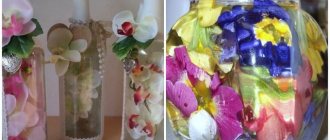Live cut flowers are inferior to preserved flowers in many respects. They are beautiful, but their life in a vase with water is fleeting. Stabilized ones are superior to freshly cut ones and have a number of advantages:
- They do not lose their spectacular appearance for several months and even years.
- They do not emit harmful substances into the atmosphere.
- Suitable for placement in rooms where allergy sufferers live. Such flowers are devoid of pollen and therefore do not cause allergic reactions.
- They are easy to care for and do not collect dust.
- Versatility in use, plenty of scope for creating fancy phyto-compositions.
Using a preservative is a great way for those wondering how to preserve flowers given for a special occasion. For example, roses given for a wedding will delight and remind you of the special event until the anniversary.
What flowers can be stabilized
Not all plants can be embalmed. Only specimens with dense stems are suitable. Designer bouquets are made of roses, peonies, orchids, gardenias, chrysanthemums, and gerberas. Moss is used for vertical decoration.
Preserved moss wall
With the help of dyes it is painted in the most unusual colors.
Herbs and leaves are woven into the composition:
- eucalyptus;
- bergrass;
- fern;
- palm leaf;
- papyrus;
- lavender;
- largus;
- pampas grass.
Small ornamental trees are actively stabilized. They are installed in rooms, halls, greenhouses, and winter gardens. This is orange, myrtle, lemon.
DIY stabilized flowers
You can preserve flowers with your own hands. For this you will need:
- pharmaceutical glycerin;
- hot water;
- glass containers;
- Natural flowers.
How stabilized flowers are made:
- Prepare a preservation solution - part glycerin and two parts hot water.
- Before placing flowers in water, you need to divide the plant stem into several parts with a knife so that more liquid can flow.
- The flower is placed in the solution for 2-3 weeks. Every day the stem needs to be trimmed by 1 cm. The glycerin solution can be changed once a week. When the leaves of the plant become more elastic and the buds themselves change color slightly, it means the work was a success.
- Then you can assemble a beautiful composition from glycerin flowers.
- You can make stabilized flowers in another way - place them in a glass container, completely fill with glycerin solution, and close with a lid. After a week, replace the solution.
- Afterwards the composition will delight you for a very long time.
Use of stabilized plants
Designer composition using stabilized plants
Professional florists and phyto-designers use flowers stabilized in a professional manner under industrial production conditions.
They create spectacular compositions, miniature paintings and entire panels.
Vertical wall decoration with moss and flowers is a modern trend in interior design.
Wall composition made of stabilized moss
Green panels bring an element of living nature into the interior and look stylish and elegant.
Stabilized plants are actively used in the design of wedding banquets, motorcades, and become decor for the hairstyle and even the bride’s outfit.
Preserved shrubs and miniature trees are installed in congress halls and used to decorate shop windows and greenhouses.
Flowers, branches, grass and leaves
Decorative flowering plants and delicate twigs are woven into a single composition that can become a gift for a special occasion. Such miniature bouquets are often placed on tables in European restaurants.
Flowers for the festive table
At home, a composition of herbs and flowers will help diversify and decorate the interior. These can be bouquets of several roses. A complex version with the inclusion of leaves of a domestic palm tree or branches of an ornamental shrub is also suitable.
Trees
Small trees are also amenable to the stabilization process, but it takes longer than in the case of flowers.
Preserved trees look like living ones and retain the freshness of their crowns for up to 15-20 years. A tree installed indoors does not require special care and does not need to be watered. Bonsai are very popular. To grow and maintain the shape of such a tree, gardeners have to work hard, but a stabilized bonsai will not require any care.
Mosses
Wall composition of stabilized plants
Due to its peculiarity, moss looks luxurious in small panels and large wall installations. They are increasingly used to decorate the interiors of offices, restaurants, and public institutions. Stabilized moss retains its structure perfectly.
It retains its natural color well even after the canning process, and the ability to paint it in different colors expands the space for implementing the most unusual design ideas.
Design solutions using stabilized moss
Compositions of stabilized flowers
Unfading plants are used in interior design of houses, apartments, catering establishments, and banquet halls.
You can try to create a stabilized flower yourself and place it in a vase at home.
Designer bouquet
Bouquets of embalmed flowers at home are environmentally friendly, do not require special care, and remain fresh for a long time. Stabilized roses are very popular. They go well in combinations with other plants and look impressive in mono bouquets. Good to read: An important part of every bouquet is the details.
Stabilized flowers in a flask
Present.
Photo from pixabay.com This souvenir will be a wonderful gift for any occasion. A rose in a flask can be presented to a loved one or manager.
Making such a souvenir yourself is not difficult, but it will take time. The master class looks like this step by step:
- stabilize the flower;
- make a hole in the wooden stand;
- secure the stem with a nail;
- cover the rose with a flask.
A composition of stabilized flowers can include not only one rose, but also herbs and other flowering crops.
Flower arrangement - table decoration
Paintings from stabilized flowers
If you embalm different plants and give them bright colors, you can make a panel with your own hands.
The basis of the picture is a cardboard or wooden base on which flowers and herbs are attached. Before making stabilized flowers, prepare the base and baguette. The panel can be placed under glass or left without it - the plants will look good in any form. Phyto-designers decorate entire walls and display cases using embalmed cultures.
Moss is most often used; it retains its texture and rich colors for a long time.
Stabilized moss in the interior. Video
Wreath of preserved flowers
Moss and unfading flowers will serve as materials for creating an elegant piece of decor, for example, in a New Year's style. You will need a base in the form of a circle. It can be made of cardboard, wood or foam. The plants are attached using a glue gun, the composition is decorated with ribbons, beads, and New Year's attributes.
Preserved flowers in a pot
The interior composition can be decorated in a beautiful pot or flowerpot. Stabilized roses of different sizes, eucalyptus branches, moss, and herbs are suitable for it. A spongy material is placed at the bottom of the container into which the plants are inserted.
Choose a shallow pot or container so that the composition, rather than its body, attracts the eye.
Flower arrangement in a pot
Stabilized flowers in a glass pot look impressive. Florariums fit perfectly into the interior of a variety of rooms.
Plant stabilization for lazy romantics. Well, geeks too
Roses in a flask are the most popular souvenir from stabilized plants. I think this is a very cool story when you gave flowers, and they don’t fade for a whole year!
The stabilized plant resembles a freshly cut flower more than a mummified carcass from a herbarium. It remains elastic - you can touch it without fear that the plant will crumble when touched.
There is no miracle at the heart of stabilization: the usual laws of physics and biochemistry, simple ingredients and wide scope for experimentation. Although manufacturers still have their secrets.
Recently, in the Belgorod city Boiling Point, a meeting was held with the owners of a herbal studio. It was about stabilized plants and their use in the interior. This is a great topic that we decided to delve into and figure out why and under what conditions moss or a sprig of lavender can remain fresh for years.
A little history
Stabilization is the replacement of plant juices with a special preservative solution that inhibits the process of cell death and destruction. Typically, glycerin is used as such a solution, but there are other options: paraffin, gelatin, wax, saline solutions.
Composition with tinted stabilized moss
The first stabilized plants appeared a long time ago. Putting a freshly cut flower in a highly salty solution or dipping a rose in paraffin - this could have been thought of both in the Middle Ages and in some Bronze Age. But it was only in the 20th century that it was possible to use a scientific approach and refine the stabilization technology.
The developers of the technology are considered to be the spouses Jeanette and Paul Lambert, who in the 70s created an industrial method for preserving cut flowers. But they started with lichen.
The Lamberts drew attention to the ability of moss to live on any surfaces and soils, even on bare stones. The fact is that lichen has no roots, and it absorbs moisture with the minerals it needs over its entire surface. When dryness sets in, the moss dries out, but when moisture appears, it returns to its previous state.
If moss can do it, why not repeat this trick with rootless flowers? And why not saturate them not with water, but with something else that does not evaporate so quickly? The couple began trying different liquids. Soon they managed to obtain stabilized moss, and then flowers.
The Lamberts moved from Belgium to Kenya, started a flower plantation and plunged into experimentation. As a result, in 1981 they filed a patent for stabilizing plants using a glycerin solution.
Kenyan workers at the Vermont Flowers EPZ stabilized plant factory, Nairobi, 2011. REUTERS/Thomas Mukoya
Basic stabilization algorithm
To obtain a good result, the Lamberts found the correct algorithm for producing stabilized colors.
First, plants need to be cut at their peak. Plants that are too young have a weak structure, while old plants have reduced permeability.
Second: it is necessary to minimize contact with the external environment and moisture loss before processing. To do this, immediately after cutting, the plants are placed in sealed containers and protected from sunlight.
Third: partial dehydration is necessary to make the plant “want to drink.” And after that, let him drink plenty of the stabilizing glycerin solution. This procedure lasts several weeks. A sign of complete replacement of water will be glycerin “tears” that appear on the surface of the leaves.
Behind the apparent simplicity of the process are hidden nuances on which the appearance and durability of the stabilized plant depend. How, with what and for how long to dry? What concentration should you make the glycerin solution and what components should you add to it to speed up the process, enhance preservation and give the desired color? The search for the optimal option continues to this day.
A simple experiment at home
You can easily make a stabilized plant at home. Take, for example, a freshly cut rose up to 50 cm long. Leave it for several hours in an empty container to pre-dry from surface moisture. To do this, you can take an ordinary vase, and during the process make sure that the plant does not begin to wither. Then we prepare a solution of water and glycerin in a 1:1 ratio, add dye there (you can take regular brilliant green). It is needed to give the plant a brighter shade. Then we cut the stem a couple of centimeters and put it in the solution. Cover the top of the container with the flower with cotton wool or cloth to reduce evaporation.
All that remains is to shorten the stem a little during the first week so that the plant continues to absorb the solution. In 2–3 weeks the rose will be completely ready. All that remains is to pull it out and hang it down with the bud to dry for a couple of days. It is mothballed for the next year. It looks like a miracle, but not for those who remember physics, chemistry and botany at least as part of the school curriculum.
A little physics and chemistry: why plants wither
Let's remember: water accounts for up to 90% of the mass of plants. Water rises from the roots through xylem vessels and approaches each cell. Mature plant cells have a large central vacuole containing water with nutrients dissolved in it. It is this vacuole that is tightly pressed against the cell wall and “holds its shape” in leaves, stems and buds.
Due to self-regulation mechanisms, plants are able to maintain a constant level of water content, continuously absorbing water and evaporating it.
The release of water vapor by a plant into the atmosphere through leaves and petals is called transpiration. Water evaporates from the surface of wet cells, seeps through the intercellular space and exits through open stomata on the surface of the leaves or the cuticle.
Stabilized lavender
In a cut plant, even immediately immersed in water, the natural processes of water movement are disrupted.
The cut stem does not provide the same osmotic pressure as the root; the channels on the cut line clog the air and are populated by microorganisms. All this shifts the water balance, and the plant begins to lose more moisture than it receives.
The lack of nutrients and mineral salts needed by the plant in the water also affects it. As a result, plant cells consume the reserve that is in the vacuoles, their strength decreases, and the plants wither.
On the left is a rose in ordinary water, on the right is in a stabilizing solution
To extend the life of a plant, you can go in different ways: provide it with water, supply nutrients, slow down the process of moisture evaporation. Glycerin acts in all directions at once.
How does glycerin work?
Glycerol is the simplest trihydric alcohol with the formula C3H5(OH)3. It looks like a viscous transparent liquid and is non-toxic. With water it creates an ideal mixture in any concentration. At the same time, it is very hygroscopic: pure glycerin is capable of drawing up to 40% of its own water from the atmosphere. At room temperature it evaporates very slowly.
If we dip a plant in almost undiluted glycerin, we get the opposite effect - the alcohol will draw out all the water it can reach from the plant. But if you use a solution in a concentration of 1:1 or more diluted, glycerin will quietly and peacefully penetrate into all cells and greatly inhibit water loss.
In addition, the plant uses glycerin as an energy source, breaking it down into carbon dioxide and water. This is very useful, since photosynthesis no longer works in a stabilized plant.
Other preservation methods
The glycerin preservation method has three weaknesses.
First: it’s long, the whole process takes about a month.
Second: glycerin is a breeding ground for a number of bacteria, so containers with it must be cleaned and the solution changed.
Third: like a decent alcohol, glycerin is flammable - a flash is possible already at a temperature of 150 ° C, and spontaneous combustion is possible at 260 ° C.
To speed up the process, denatured alcohol and acetone are added to the solution.
The standard solution for chemical preservation is a solution of alcohol, acetone and glycerin in a ratio of 1:1:2. The soaking period is reduced to 6–10 days.
But, frankly speaking, the result of such conservation can hardly be called environmentally friendly.
Composition with stabilized moss, Belgorod studio Mossty
One of the latest patents in this area - RU 2 698 058 C1 - was received by our compatriot in 2022. She suggests the following procedure for processing plants:
- First, we immerse the plants for 24 hours in sealed containers with distilled water and a set of sugars in a ratio of 10:1 at a temperature of 15–30 °C.
- Then for bleaching for another 24 hours - in sealed containers with an aqueous solution of hydrogen peroxide in a ratio of 3:10, then for another 48 hours in a 10-15% aqueous solution of titanium dioxide.
- Then, for 72 hours, we immerse the plants in sealed containers with a preservative solution containing glycerin and acetylated lanolin in a 1:1 ratio, as well as dye at 25–40 °C.
- The last operation is drying at 20–80 °C. Total 7–8 days.
To protect glycerin from bacteria, preservatives are used, including phenols, sodium benzoate, formalin and alcohols. The ingredient and its concentration is the know-how of every manufacturer of stabilized plants.
To produce non-flammable stabilized plants, mineral salt solutions without glycerin are used, but the physics and chemistry of the process and the result are completely different. The plants are tougher and less vibrant.
As for phytostudios, almost all of them purchase ready-made stabilized moss from manufacturers. Here's what Alexander Kremensky, co-owner of the Belgorod studio, says:
“Lavender is from Holland, moss is from the north, Russian. We tried the Scandinavian one, but the Russian one is much better: it’s prettier, cleaner, has bigger caps, and is native. Recently, “atmospheric moss” has appeared - it can even be used outdoors. He is not afraid of snow, rain, cold weather. But it feels a little harder.”
What can be stabilized
Stabilization gives good results when working with lichens (moss moss), mosses (tussock-bryozoan, for example), miniature trees and flowers with strong elastic stems and buds. Plants such as dandelion, lily of the valley, peony, and sunflower are not suitable for saturation with glycerin.
Some plants change color when soaked. Eucalyptus turns greenish-brown, beech leaves turn black, and sweet olives, loquats and magnolias turn brown. The colors of other plants lose their saturation. Therefore, plants are often first bleached and then dye is added to the glycerin solution.
Among mosses and lichens, the most spectacular species are those of the genus Cladonia (Cladonia stellaris), better known as “reindeer moss” or reindeer moss. In nature, reindeer moss is white-gray in color, so it can be easily painted in almost any shade. The most popular are shades of green. But people prefer flowers in natural colors.
How long do plants keep their appearance?
Depends on conditions and care. With mosses it lasts from two to ten years. But some creators claim that they will live to 50. Roses - two years or less. If in a flask, then usually three to five, although some manufacturers promise as many as seven. In the latter case, the process of stabilizing roses is more complex, where the stem and the flower itself are processed separately.
What is this all for?
A stabilized plant lives for several years; it does not need to be planted in the ground, fed, or watered. It looks like it was just cut and even smells a little.
Now installations from such plants are very popular. Many restaurants have “freshly cut” flowers on the tables. And entire walls made of stabilized moss began to appear in offices.
However, there are a few important points to consider when using stabilized plants in your design.
First : they cannot be watered. The water will begin to wash the glycerin out of the flower, and it will spoil.
Second : do not place it in direct sunlight. The sun starts the decay process and increases the evaporation of glycerin, the flower or moss will dry out.
And third : keep your composition away from open fire. One stray coal will be enough to create a small “eco-badboom”.
Interestingly, stabilized moss can serve as an indicator of indoor humidity. If everything is ok, it will be soft and bright. And if the air is too dry, it will begin to change color and harden. In this case, it is enough to turn on the humidifier, and the moss will recover: the glycerin itself will draw the moisture necessary for the plant from the air.
Another interesting property of stabilized plants is that they are antistatic, so dust does not easily settle on them.
This is also the merit of glycerin: it creates a thin film of water on the surface of the leaves, along which charges flow.
In general, conservation technology has not yet reached its maximum development, so we can expect new discoveries in this area. But the current level is quite enough to give roses to your wife and then tell her for a whole year that they will not fade, because they were given with love. The main thing is that she doesn’t start watering them.
How to prepare plants for preservation
In industrial production, roses and other plants are kept in sealed containers for a certain time and only after that they begin to stabilize.
Before embalming begins, the plants are cleaned of pollen and contaminants, the stems are trimmed, and dried for several hours.
The production facilities have the necessary equipment, and the solution formulas are more complex than the options that are prepared for home use. Therefore, not all plants will be able to be embalmed on their own. Roses are best suited for this experiment. They have a dense flexible stem, and the petals, after stabilization, remain tender and retain the elasticity of the tissue.
Stabilized flowers – what are they?
Floristry lovers are interested in the question: stabilized flowers - what are they? A new technology is applied to plants, which allows them to be preserved miraculously; such bouquets remain fresh for several years and are endlessly pleasing to the eye. After special processing, the flowers seem to be preserved, which is why they are also called “unfading flowers”, “immortal flowers”, “eternal flowers”. They retain their natural appearance and natural charm, strength and elasticity for years.
How are stabilized flowers treated?
Stabilization technology involves replacing natural plant sap with a special glycerin composition. Thanks to this, the culture remains strong, flexible, has a fresh appearance, natural color and is virtually no different from its living counterpart. All flowers (especially roses) undergo strict selection for the shape and quality of the bud. Some producers discolor the cut plant for several days. After this, a shade is selected for each flower and a paint formula is drawn up. Thanks to this, you can get a bud of any color - from natural to the most juicy and unusual.
The stabilization process itself goes like this: the flower is grown traditionally and cut in its most beautiful flowering phase. The natural juices of the plant are extracted from the bud and stem in a special way and filled with a glycerin-based composition. The flower itself is placed in this life-giving solution for a month. After this treatment, stabilized plants are ready for a long life.
Industrial options for stabilizing flower arrangements
The process is based on the ability of glycerin to nourish the plant and not evaporate.
Pure glycerin is not suitable for high-quality creation of timeless flowers. It will simply draw out all the vital juices from the stem.
Those who first heard what stabilized flowers are and want to try to preserve a purchased wild rose or gerbera at home will have to study the features of embalming.
In production, solutions are prepared taking into account various features.
The plant must receive moisture, so glycerin is diluted with water. Alcohols, acetone, and preservatives are added to the composition.
Dyes are actively used; they diversify the color palette and allow you to obtain flowers with an unusual shade. To ensure that the composition is not only effective, but also exudes a pleasant aroma, flavoring compounds are used.
Artificial plants or stabilized ones: what to choose?
Despite all the advantages, stabilized plants are inferior to artificial ones in a number of parameters:
- Price. Due to expensive production, prices for stabilized flowers are high. Artificial plants stand out due to their combination of affordable prices and excellent quality.
- Natural colors and shades. Unlike artificial flowers, which are created to look as natural as possible, stabilized flowers lose their color during production. Manufacturers dye stabilized flowers, but their shades are often dull and unnatural.
- Aroma. Artificial flowers are odorless, which is a big advantage for people prone to allergies. Companies that produce stabilized plants often use different aromatic compositions to imitate the smell of flowers and herbs. Low-quality components of such compositions can provoke an allergic reaction.
- Durability. Artificial plants are characterized by a long service life and external influences. When choosing stabilized plants, remember that they lose their appearance when exposed to sunlight and water.
According to Feng Shui philosophy, dried and “non-living” plants (stabilized plants are among them) should not be stored in the house, as they concentrate negative energy and disrupt the flow of natural energy.
Other preservation methods
At home, stabilization methods are available with compositions of glycerin diluted with water in different concentrations.
- Prepare a solution from equal parts of glycerin and water.
- Dip the prepared plant into the liquid completely or to the base of the bud.
- After a week, the solution is replaced with a fresh one.
- Every 5-7 days, the flower is removed and the cut is trimmed - this will speed up the process of penetration of the composition into the tissue.
A sign that stabilization has completed will be droplets of moisture on the petals.
The embalmed flowers are taken out and hung with the bud down to drain the liquid. Now you can use them to create compositions.
How to preserve flowers with wax
Another method available at home is flowers stabilized with paraffin. It does not require as much time as stabilization with glycerin, but requires dexterity, which is acquired with experience.
Cosmetic paraffin can be purchased at a specialty store. Before starting the process, the wax should be melted in a water bath and cool slightly.
Turn the rose upside down, dip it in liquid paraffin for a minute and remove it. After 2-3 minutes, repeat the dip and remove from the wax again. The number of dives is 4-5 for each flower.
The paraffin hardens and seals each petal. At the same time, the brightness of the bud will not fade.
A stabilized rose will last for several months. If desired, the bud can be painted by spraying paint from a spray bottle or painted with a thin brush.
How are stabilized flowers made and how long do they last?
Stabilized flowers are obtained after treatment with special compounds, due to which they are able to retain their original appearance for a long time. Compositions made from stabilized flowers are convenient because they do not crumble and require no maintenance, are odorless and do not cause allergies.
It is quite difficult to make a high-quality stabilized bouquet with your own hands, but it is quite possible to preserve some types of plants.
The general principles of “embalming” plants are as follows:
- Freshly cut flowers are allowed to wilt a little.
- A preservative solution is prepared from various ingredients (glycerin, paraffin, wax).
- The cut of the flower is shortened and placed in the composition. During the first week, the tip of the stem is trimmed daily.
- In general, the plant must be kept in the solution for two weeks. During this time, it will be saturated with the necessary substances and embalmed naturally.
The main advantage of this procedure is the increased shelf life. Such flowers can last in bouquets or compositions for up to several months, and branches or decorative leaves can last for 2-3 years. If you try to preserve the shrub, it will delight you with its freshness for several years.
Stabilizing flowers at home
Having mastered the skills of stabilizing flowers, you can create extraordinary bouquets with your own hands that can easily decorate your apartment, workplace, or country house. Preserved plants are suitable for gifts. Of course, today you can buy an inexpensive bouquet or a chic arrangement at any time, but no one has canceled your crazy hands... Try to make a floral present yourself.
Choose…
In addition to fresh flowers, small trees and bushes can be stabilized. They are as decorative as plants in pots, while keeping the crown dense throughout the year. Diseases and pests will bypass such flowers.
When considering which flowers to immortalize, carefully examine the leaves and stems of the candidates. These parts must be strong - the stronger, the longer the preserved plant will last without losing its original appearance. Choose flowers with thick stems and petals that can withstand the elements.
It is worth finding out in advance how well the plant tolerates stabilization. It happens that the same representative of the flora of different varieties reacts differently to the procedure. One becomes unusable already during conservation, and the second brings joy to the owner for a long, long time.
Source: m.russian.alibaba.com
Glycerin is the best way to extend the life of a plant.
Glycerin is a transparent, non-toxic, trihydric alcohol soluble in water. It is distinguished by increased hygroscopicity, that is, when in contact with air, glycerin absorbs a lot of moisture.
The substance evaporates slowly at room temperature. An aqueous solution of glycerin is used to preserve flowers. Penetrating through the stems to the plant cells, it fills them, preventing moisture from being lost.
There are two ways to preserve flowers using glycerin, which are used at home.
First way:
First you need to cut a plant whose stem length does not exceed 50 centimeters. A rose or lily would be ideal. It is necessary to keep the flower in a horizontal position for four to five hours. This is done so that the moisture evaporates. You need to make sure that the plant does not wilt. After this, glycerin is mixed with water in a one-to-one ratio and the flower stem is placed in the resulting solution. You can tint the liquid with brilliant green or food coloring to give the plant a rich shade.
It is necessary to cover the container with a cloth. Thanks to this, less liquid evaporates. Place the vessel in a dark, dry place. It is necessary to add the solution to maintain its original level and make cuts on the stem within a week, facilitating the flow of essence into the pores of the plant. You will have to wait 21 days for the flower to stabilize. At the end of the procedure, you need to take out the “preservative” and hang it vertically to dry.
The new accessory is ready! You can give it to someone as a gift, or put it on a shelf in your room. The plant kept in a glycerin solution is stored for a whole year.
In the second method of stabilization in glycerin, a solution diluted in a ratio of one to two is used. The mixture must be heated to 70°C, after which a flower with the cut end of the stem should be placed in it.
The procedure lasts two weeks, if plants with large buds are taken - three. To make the solution absorb better, you can divide the end of the stem into two halves and remove the skin from it. This stabilization method is also suitable for autumn tree branches and spruce legs.
Benefits of Glycerin:
- inflorescences and leaves retain their beauty for a long time;
- the stabilization composition does not harm the environment and the human body;
- preserved flowers are elastic, with a glossy sheen.
Disadvantages of glycerin:
- preservation lasts a long time;
- Flowers with thick stems and strong petals are suitable for the procedure;
- darkening of the petals is possible.
Tip : to keep preserved plants in their original appearance even longer, place them in a glass flask. A closed space guarantees protection from moisture and dust.
Stabilized flowers - storage
Preserved bouquets of stabilized flowers do not require special care, but there are some rules for storing them that will help extend the life of plants:
- Avoid getting liquid on buds and foliage. Some stabilized trees are allowed to be sprayed and wiped with a damp cloth, but placing them in water or watering is strictly prohibited.
- You cannot store fresh, stabilized flowers in damp rooms - in saunas, baths, swimming pools.
- The optimal humidity level for storage is 60-80%. In a dry room, stabilized flowers may dry out.
- The optimal temperature for stabilized flowers is from +5°C to +35°C; sudden changes should be avoided.
- Flowers in glycerin should not be exposed to direct sunlight, halogen lamps or other sources of high temperature.
Caring for stabilized flowers
Unfading treated flowers do not need watering, fertilizing, replanting, do not require good lighting, and are not affected by fungi, insects, or diseases. Caring for them involves maintaining a certain level of humidity in the room so that the buds do not dry out prematurely. Dust from plants should be removed with a vacuum cleaner or hair dryer in cold air flow mode (at low speed) or use a soft dust brush. In a room with excessively dry air, it is better to install a humidifier.










